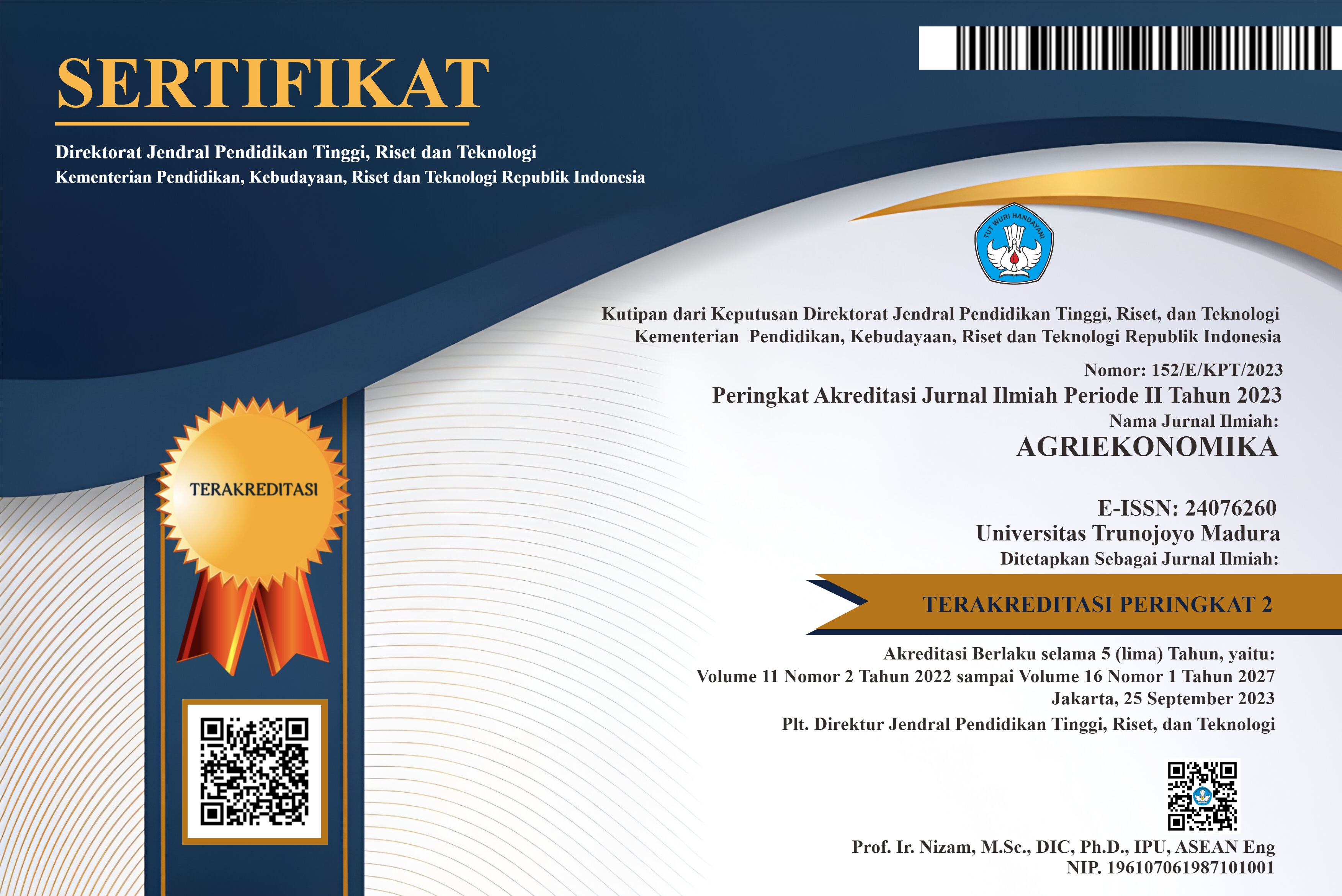The Role of Rice’s Price in the Household Consumption in Indonesia
Abstract
Keywords
Full Text:
PDFReferences
Arthatiani, F. Y., Kusnadi, N., Harianto. (2018). Analysis of Fish Consumption Patterns and Fish Demand Model Based on Household’s Characteristics in Indonesia. Jurnal Sosial Ekonomi Kelautan dan Perikanan, 13(1), 73–86.
Deaton, A., and Muellbauer, J. (1980). An Almost Ideal Demand System. The American Economic Review, 70(3), 312–326.
Dey, M.M., Garcia, Y.T., Kumar, P., Piumsombun, S., Haque, M.S.H., Li, Luping, Radam, A., Senaratne, A., Khiem, N.T., Koeshendrajana, S. (2008). Demand for Fish in Asia : A Cross-country Analysis. The Australian Journal of Agricultural and Resource Economics 52, 321-338. doi:10.1111/j.1467-8489.2008.00418.x.
P.O.I. Erhabor and O. Ojogho. (2011). Demand Analysis for Rice in Nigeria. Journal of Food Technology, 9, 66-74. doi:10.3923/jftech.2011.66.74.
Ilham, N., Saptana. (2019). Fluctuations in the Chicken Egg Price and Its Determining Factors. Analisis Kebijakan Pertanian, 17(1), 27–38. http://dx.doi.org/10.21082/akp.v17n1.2019.27-38.
Lantican, F. A., Sombilla, M. A., Quilloy, K. P. (2013). Estimating the Demand Elasticities of Rice in the Philippines. Philippines: SEARCA.
Malian, A. H., Mardianto, S., Ariani, M. (2004). Faktor-faktor yang Mempengaruhi Produksi, Konsumsi dan Harga Beras serta Inflasi Bahan Makanan. Jurnal Agro Ekonomi, 22(2), 119-146. http://dx.doi.org/10.21082/jae.v22n2.2004.119-146.
Miranti, A., Syaukat, Y., Harianto. (2016). Pola Konsumsi Pangan Rumah Tangga di Provinsi Jawa Barat. Jurnal Agro Ekonomi, 34(1), 67–80. http://dx.doi.org/10.21082/jae.v34n1.2016.67-80.
Nugroho, S., Suparyono, W. S. (2015). Household Level Meat Demand Pattern in Indonesia: Micro Data Analysis 2013. Jurnal Ekonomi dan Pembangunan Indonesia, 16(1), 47–58. http://dx.doi.org/10.21002/jepi.v16i1.668
Nur, Y. H., Nuryati, Y., Resnia, R., & Santoso, A. S. (2012). Analisis Faktor dan Proyeksi Konsumsi Pangan Nasional: Kasus Pada Komoditas: Beras, Kedelai dan Daging Sapi. Buletin Ilmiah Litbang Perdagangan, 6(1), 37-52. https://doi.org/10.30908/bilp.v6i1.137.
Oyinbo, O., Omolehin, R. A., Abdulsalam, Z. (2013). Analysis of the Demand for Rice in Kaduna State, Nigeria. Agris on-line Papers in Economics and Informatics, 5(3), 45–52. doi:10.22004/ag.econ.157584.
Pontoh, R., Palar, S. W., Maramis, M. T. B. (2016). Permintaan dan Penawaran Beras di Indonesia (Pada Tahun 2003-Tahun 2013). Jurnal Berkala Ilmiah Efisiensi, 16(04), 833–844.
Le Quang, Canh (2008): An Empirical Study for Food Consumption in Vietnam. ASEAN Economic Bulletin, 25, 283-292.
Rohman, A., & Maharani, A. (2017). Proyeksi Kebutuhan Konsumsi Pangan Beras di Daerah Istimewa Yogyakarta. Caraka Tani: Journal of Sustainable Agriculture, 32(1), 29-34. http://dx.doi.org/10.20961/carakatani.v32i1.12144
Saputri, R., Lestari, L. A., Susilo, J. (2016). Pola Konsumsi Pangan dan Tingkat Ketahanan Pangan Rumah Tangga di Kabupaten Kampar Provinsi Riau. Jurnal Gizi Klinik Indonesia, 12(3),123–130. https://doi.org/10.22146/ijcn.23110
Septiadi, D., Harianto., Suharno. (2016). Dampak Kebijakan Harga Beras dan Luas Areal Irigasi Terhadap Pengentasan Kemiskinan di Indonesia. Jurnal Agribisnis Indonesia, 4(2), 9-106. http://doi.org/10.29244/jai.2016.4.2.91-106.
Setiawan, E. (2016). Dampak Kebijakan Perberasan terhadap Diversifikasi Pangan Pokok dan Ketahanan Pangan Nasional. IPB.
Silalahi, N. H., Yudha, R. O., Dwiyanti, E. I., Zulvianita, D., Feranti, S. N, Yustiana, Y. (2019). Government Policy Statements Related to Rice Problems in Indonesia. 3BIO: Journal of Biological Science, Technology and Management, 1(1), 35–41.
Taniguchi, Kiyoshi., & Chern, Wen S. (2000). Income Elasticity of Rice Demand in Japan and Its Implications: Cross-Sectional Data Analysis. Annual meeting, American Agricultural Economics Association (New Name 2008: Agricultural and Applied Economics Association). Ohio: Ohio State University.
Timmer, C. P. (2014). Food Security in Asia and the Pacific: The Rapidly Changing Role of Rice. Asia Pacific Policy Stud, 1(1), 73–90. http://doi.org/10.1002/app5.6.
Traore, T. M., Deacue, F. I. (2017). Household Demand For Staple Cereal Comodities and Analysis of The Evoluation of Staple Cereals price In Burkina Faso. International Journal of Food and Agricultural Economics (IJFAEC), 5(2), 79–96. http://doi.org/10.22004/ag.econ.266473
Wijayati, P. D., Harianto., Suryana, A. (2019). Permintaan Pangan Sumber Karbohidrat di Indonesia. Analisis Kebijakan Pertanian, 17(1), 13–26. http://dx.doi.org/10.21082/akp.v17n1.2019.13-26 13.
Yeong-sheng, J., Nasir, M., Mahir, Abdullah, Z., Radam, A. M. (2009). Demand Analyses of Rice in Malaysia. MPRA Paper. https://mpra.ub.uni-muenchen.de/15062/.
Yuliana, R. (2018). Permintaan Pangan dan Perubahan Tingkat Kesejahteraan Rumahtangga di Indonesia. IPB.
DOI: https://doi.org/10.21107/agriekonomika.v9i1.6962
Refbacks
- There are currently no refbacks.







